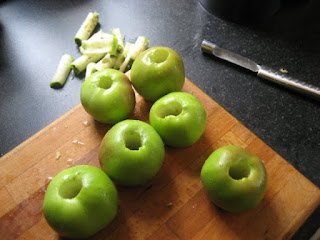 This first scrumpy is a traditional English farmhouse scrumpy, made from apples and honey and nothing else. A friend asked me how to make cider recently so I'm going to write this as a short "Beginner's Guide". Making cider is easy and if you have trees or friends with trees then it's very cheap!
This first scrumpy is a traditional English farmhouse scrumpy, made from apples and honey and nothing else. A friend asked me how to make cider recently so I'm going to write this as a short "Beginner's Guide". Making cider is easy and if you have trees or friends with trees then it's very cheap!Step One
Pick some apples! You'll need quite a lot, a mix of sweet (eating) apples and crab apples or cooking apples will work best. I've used about 60% eating and 40% cooking apples here. Stick them in a large bucket filled with water and leave them for a few hours, this will bring any insects that were sat on you apples to the surface, which is better than having them scampering across your kitchen surface. If you are trying to make cider without adding any yeast then let the apples dry in the sun, or don't wash them in the first place as this may remove some of the natural yeasts. The yeast will be on the skins of the apples so don't peal them either!
 Step Two
Step TwoSterilise everything you are going to use in your cider making. I used a sterilising power, from the local homebrew shop, mixed in hot water. Rinse out your demijohns and soak your bung, airlock, apple corer and anything else you may use. When you are ready to use something just rinse off the sterilising solution.
Step Three
Next you need to turn your apples into juice. There's lots of ways to do this but the simplest is to put your apples in a bucket and crush them with a large lump of wood. Once pulped you can press them using a fruit press or squeeze them through a muslin bag.
I didn't do this, instead I cored them, chopped them and then fed them through a centrifugal juicer!

| 
|
Step Four
What you end up with, especially if you used a juicer like me,is juice that is thick and full of pulp. The next stage then is to filter some of that pulp out, I did this by letting it stand in a demijohn so most of the pulp sank, then I syphoned it into a clean demijohn. Next I filtered it further by squeezing it through a muslin cloth or bag.
Step Five
 I put this final juice into a clean demijohn and added some honey, about half a jar. That's it, I put an air lock in and put it away. That was a few days ago and I can confirm that it is now fermenting happily! This is done by using natural yeasts that are present on the apples and in the atmosphere allowing the cider to spontaneously ferment.
I put this final juice into a clean demijohn and added some honey, about half a jar. That's it, I put an air lock in and put it away. That was a few days ago and I can confirm that it is now fermenting happily! This is done by using natural yeasts that are present on the apples and in the atmosphere allowing the cider to spontaneously ferment. If you want a quicker method or have tried this and nothing is happening then you can add some yeast as follows;
Crush one campdem tablet and add it to the demijohn of apple juice, give is a shake to mix it in. Leave this overnight and it will kill off any existing natural yeasts. Then you can restart the fermentation using a cider yeast or even a wine yeast, you should definitely see some activity then. Alternatively you can use a champagne yeast which will make a sparking cider. You can buy campden tablets and wine yeast at your local homebrew shop or if you live in the UK from Wilkinsons.
Great! can you offer any instructions from this point on?
ReplyDeleteI remember buying proper scrumpy from a local pub in the 1960's. It was warm, it was cloudy, it was very alcoholic but it must have had some other ingredients as nobody could drink more than two pints without being completely off their face. The landlord wouldn't actually sell anyone more than two pints for this reason. This stuff induced a state of euphoria you just don't get with alcohol alone.
ReplyDeleteSo apart from apples, yeast and honey or sugar ... what else could I put in my cider to give it that 'legal high' effect?
Sounds great!haha
Delete